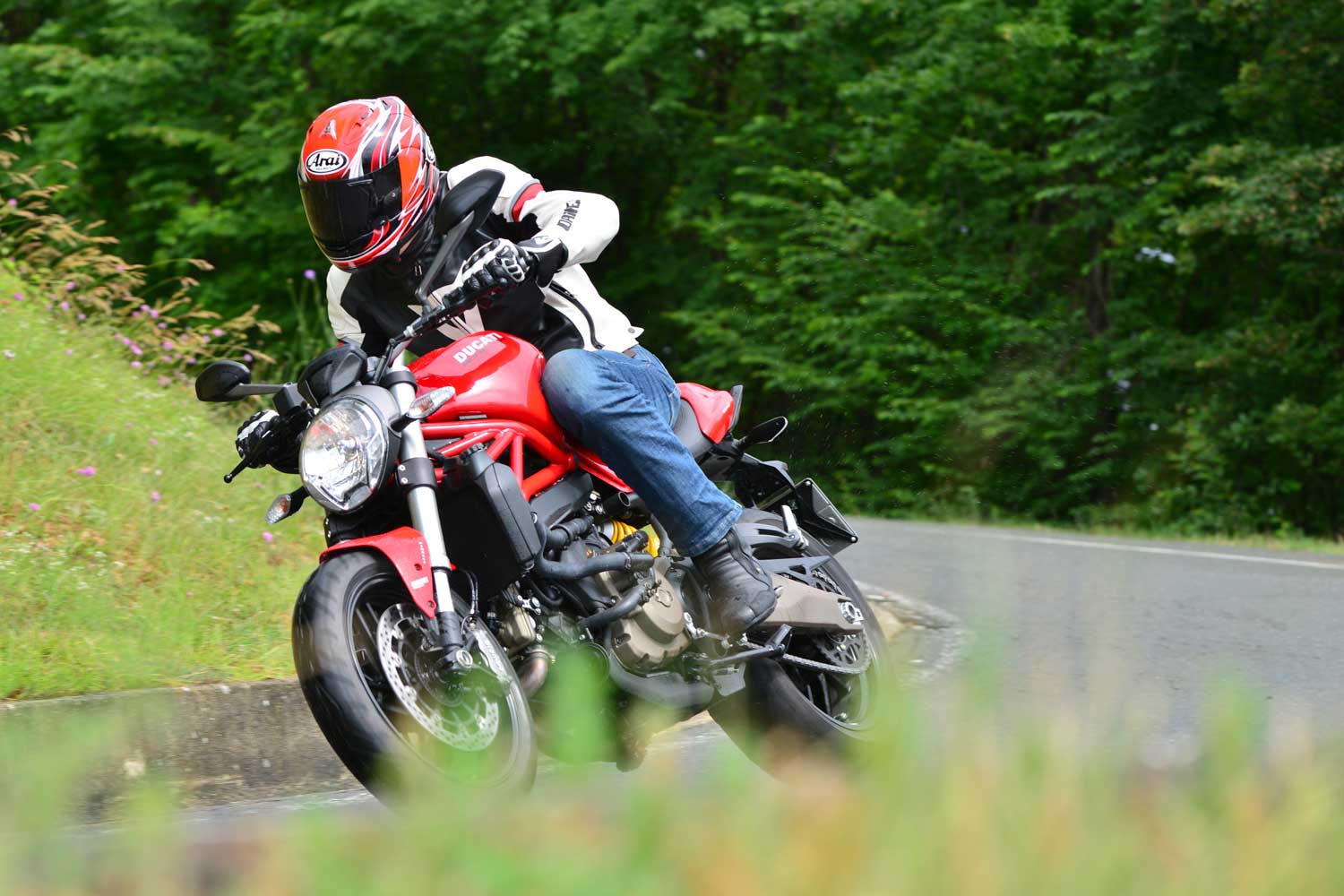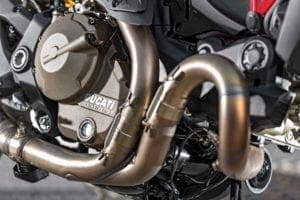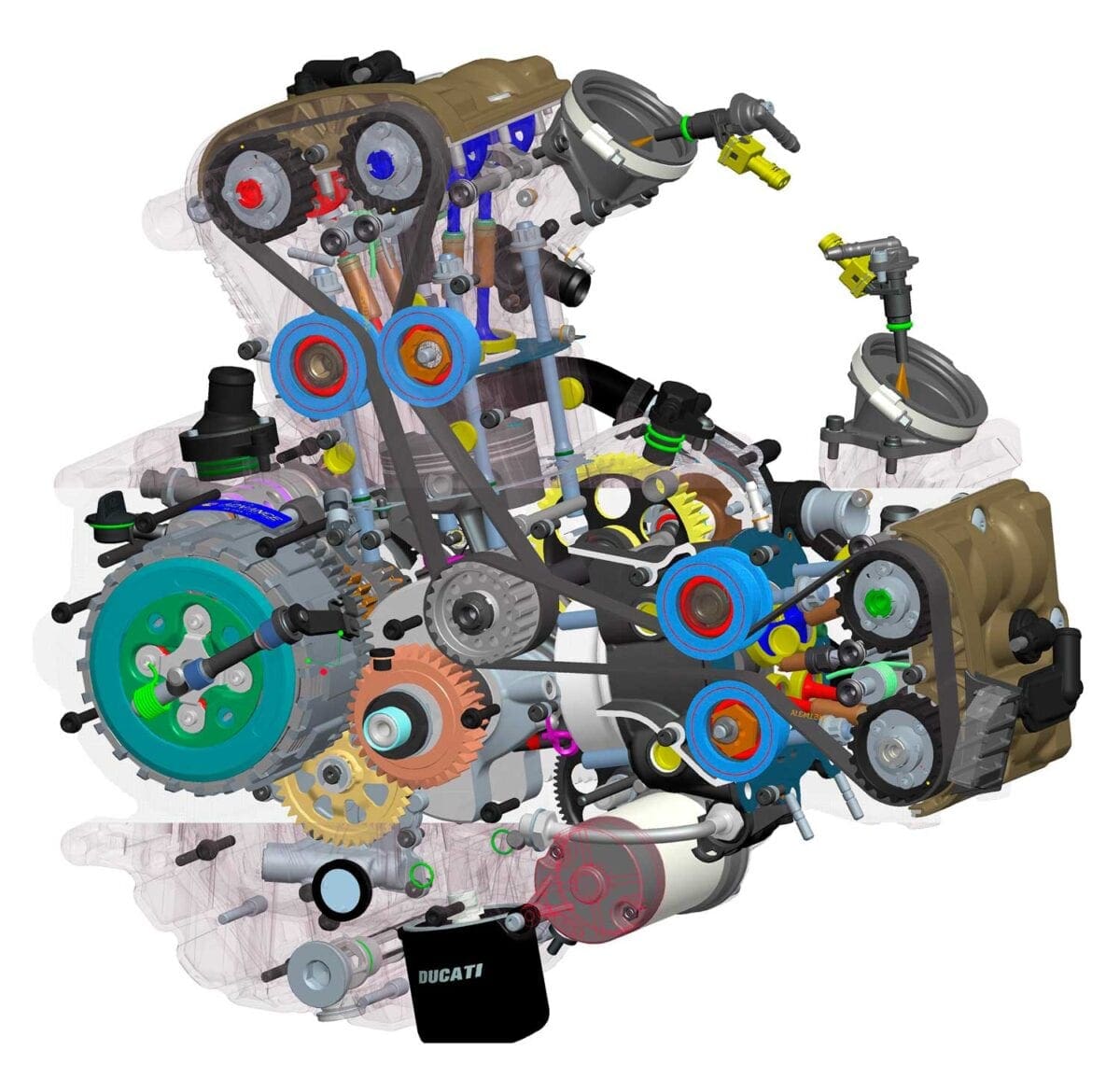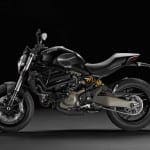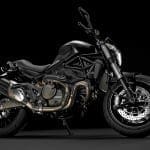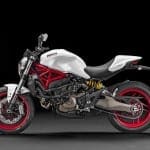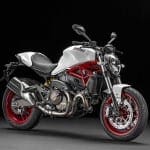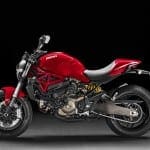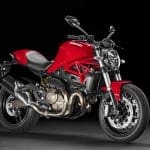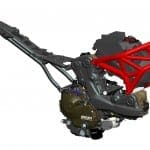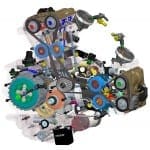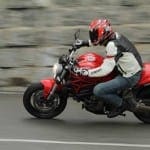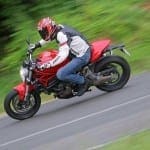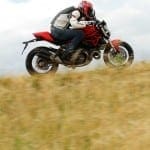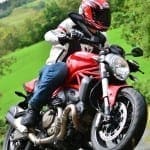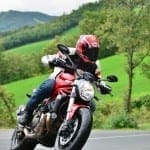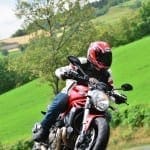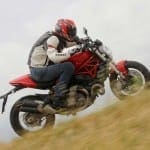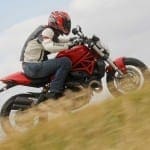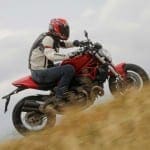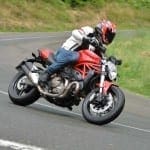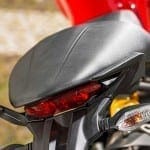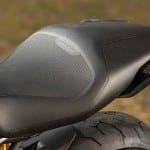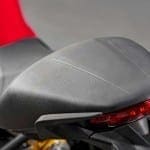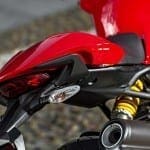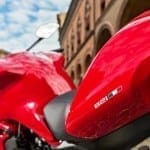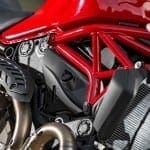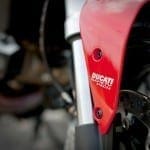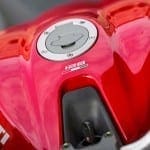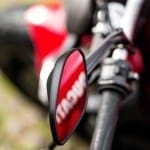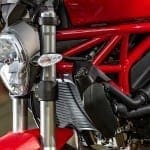£8995 | 112bhp@9250rpm | 65.9lb-ft@7750rpm | 821cc liquid-cooled V-twin
Tested by Roland Brown. Motorcycle Journalist and former international racer, Roland Brown is one of the world’s most respected bike testers. Subscribe to his fantastic YouTube channel – iMotorcycle Video – here.
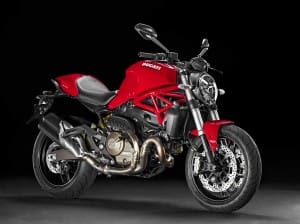 The launch of the Monster 821 is a big deal for Ducati, but nowhere near as important as the introduction of the very similar looking M900 Monster that began the naked Italian V-twin family’s story back in 1993. Since then more than 290,000 Monsters have been sold, in a wide variety of engine capacities, helping to keep Ducati healthy through good times and bad.
The launch of the Monster 821 is a big deal for Ducati, but nowhere near as important as the introduction of the very similar looking M900 Monster that began the naked Italian V-twin family’s story back in 1993. Since then more than 290,000 Monsters have been sold, in a wide variety of engine capacities, helping to keep Ducati healthy through good times and bad.
The Monster 821 has similar capacity to that original M900, and Ducati have made sure that it shares the old model’s V-twin character as well as its look. But the new bike, based on the recently released Monster 1200, is very much a new generation Monster: liquid-cooled; considerably more powerful than the air-cooled Monster 796; and much more sophisticated, incorporating ride-by-wire throttle, multiple riding modes, traction control and ABS brakes.
Relatively little engine development was required for this Monster because it’s powered by the DOHC eight-valve V-twin desmo unit that was introduced last year in the Hypermotard and Hyperstrada. The Testastretta 11 degree lump is mechanically unchanged apart from incorporating Ducati’s APTC clutch, which gives a slipper action and a very light feel at the lever.
The 821cc motor has fairly long-stroke dimensions (at 88 x 67.5mm, its bore is 8mm narrower than the 1200’s but stroke is just 0.4mm shorter) and is impressively flexible. The Monster’s output is slightly higher than the Hypermotard’s due to a larger airbox and new exhaust system with longer, equal length header pipes. This gives a slight boost all the way through the range, to a 2bhp higher maximum of 112bhp at 9250rpm.
The Monster 821 follows the 1200 in having three riding modes, selectable by pressing the indicator button. Sport and Touring deliver the full output, the latter with softer response; Urban is softer again to a reduced 75bhp maximum. Even that reduced figure is not far short of the maximum of the 803cc air-cooled Monster 796. Compared to that bike the 821’s torque curve is almost identical from 6-6500rpm but considerably higher both below and above that range.
Most of the chassis comes straight from the Monster 1200. There are no changes to the tubular steel frame, which adds rigidity and saves weight (compared to the previous Monster 796 frame) by bolting front and rear sections directly to the engine in Panigale style. But there are a few differences, notably the new aluminium swing-arm that is twin- instead of single-sided, and 30mm shorter than the 1200’s; partly because the less powerful bike can get away with a shorter, 1480mm wheelbase.
The 821 is a few kilos lighter, at 205.5kg wet, and also has a narrower, 5.50in rear wheel shod with a 180- instead of 190-section rear tyre. Suspension set-up is fairly basic, similar to that of the base model 1200, with non-adjustable, 43mm Sachs USD forks up front. The same firm’s rear shock is operated directly by the swing-arm, has a dual-rate spring and is adjustable for preload and rebound damping.
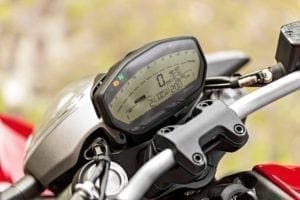 The 821’s one-piece handlebar is made from steel instead of the 1200’s aluminium but the riding position is identical, thanks also to an unchanged seat that is wider, longer and better padded than previous Monster seats, and can be adjusted to be either 785 or 810mm high. Braking follows the standard 1200 model’s format, with 320mm front discs and Brembo radial Monobloc calipers, though the 821 doesn’t get the 1200’s radial master cylinder. Ducati’s “Safety Pack” of ABS brakes and eight-level traction control comes as standard.
The 821’s one-piece handlebar is made from steel instead of the 1200’s aluminium but the riding position is identical, thanks also to an unchanged seat that is wider, longer and better padded than previous Monster seats, and can be adjusted to be either 785 or 810mm high. Braking follows the standard 1200 model’s format, with 320mm front discs and Brembo radial Monobloc calipers, though the 821 doesn’t get the 1200’s radial master cylinder. Ducati’s “Safety Pack” of ABS brakes and eight-level traction control comes as standard.
Should I buy one?
If you fancy a Monster and have previously been put off either by the old models’ lack of practicality or the new 1200’s price, then the 821 could just be the bike that breaks your resistance. It has plenty of the Italian style and appealing V-twin character that have long made Monsters popular, plus a blend of refinement, comfort and practicality that most of the previous models didn’t even approach.
Equally importantly the 821 follows Ducati’s 899 Panigale by offering most of the benefits of a larger model, in this case the Monster 1200, with a more accessible character and price. At £8995 (or £8795 for the Dark model, which has matt black paint and no pillion seat cover) it’s not particularly cheap, being closer in price to the 1200 than to the entry-level Monster 696. But it’s one of the most complete and best value Ducati models yet, and an excellent reason to join the multitude of riders who’ve bought a Monster already.
So what’s it like to ride?
It’s very entertaining and involving; and also more comfortable and practical than you might imagine. That’s true from the moment you throw a leg over the low seat and start the engine, which fires up with a thunderous exhaust note from the side-by-side silencers. Ducati has done a great job with that and also with the fuelling, which is very crisp, helping to make the Monster easy to ride in traffic, especially in Urban mode.
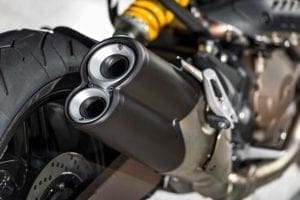 The 821cc V-twin is impressively flexible, and the Monster is docile and smooth, even when you rev it towards the 11,000rpm limit through the gears. There’s enough top-end power for plenty of excitement. On open roads the Ducati sat smoothly at 90mph and stormed briefly to 115mph, heading for a top speed of about 140mph while I failed to find much escape from the wind, and held tight to the raised handlebar, which is slightly higher and further back than the Monster 796’s.
The 821cc V-twin is impressively flexible, and the Monster is docile and smooth, even when you rev it towards the 11,000rpm limit through the gears. There’s enough top-end power for plenty of excitement. On open roads the Ducati sat smoothly at 90mph and stormed briefly to 115mph, heading for a top speed of about 140mph while I failed to find much escape from the wind, and held tight to the raised handlebar, which is slightly higher and further back than the Monster 796’s.
Ride quality was pretty good, the suspension giving a taut, reasonably firm feel while soaking up bumps with notably more efficiency than Monsters of a few years ago. Hard riding on the twisty Futa pass near Bologna, where Ducati develops most of its bikes, occasionally had the 821 moving around slightly in bumpier bends, but it gave plenty of feedback and steered very precisely. The Brembo brake system is superbly powerful, and well backed up by the Bosch ABS system. The rear disc was typically lacking in feel but the ABS meant there was no worry about locking it up.
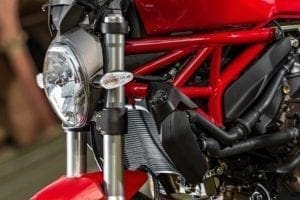 The 821’s electronic features are arguably the biggest difference between this bike and most previous Monsters, and mostly in a good way. The traction control system is a bit tricky to turn off if you want to pull wheelies, but like the ABS it was especially welcome in the wet. The LCD instrument panel is less eye-catching than the 1200’s classy coloured display but still shows fuel consumption and range to empty, incorporates a lap timer and shift light, and is adjustable for brightness.
The 821’s electronic features are arguably the biggest difference between this bike and most previous Monsters, and mostly in a good way. The traction control system is a bit tricky to turn off if you want to pull wheelies, but like the ABS it was especially welcome in the wet. The LCD instrument panel is less eye-catching than the 1200’s classy coloured display but still shows fuel consumption and range to empty, incorporates a lap timer and shift light, and is adjustable for brightness.
More importantly, Ducati have got the Monster’s basics well sorted. Its riding position is roomy; controls work smoothly; even the mirrors are useful. The 17.5-litre tank should be good for over 150 miles at a typical average of 45mpg or more. The seat was respectably comfortable, and removing its colour-matched pillion seat cover (standard fitment, except with the matt black Dark model) reveals a reasonably, if not generously, sized pillion seat with grab-handles alongside.
The Monster 821 is certainly a much more sophisticated and practical bike than its ancestor the M900, and even the much more recent 796. Equally importantly, it also manages to match the old air-cooled models’ raw V-twin character and sound. And if that sounds as though you’re getting the best of both worlds, that’s just about right. Despite its middleweight status the 821 is very much a grown-up Monster, and arguably the best one so far.
Tested by: Roland Brown Photos by: Milagro
Tech Spec:
Price: £8995 [Dark £8795]
Engine: 821cc, liquid-cooled, dohc 8-valve desmo V-twin
Power: 112bhp (82.4kW) @ 9250rpm
Torque: 65.9lb-ft (89.4N.m) @ 7750rpm
Curb weight: 205.5kg
Seat height: 785-810mm
Tank size: 17.5 litres
www.ducatiuk.com

